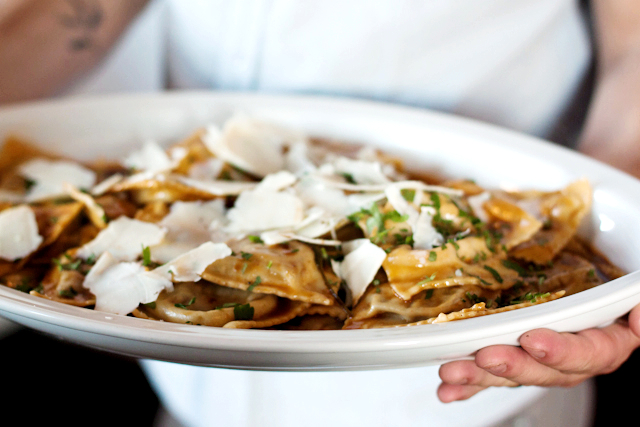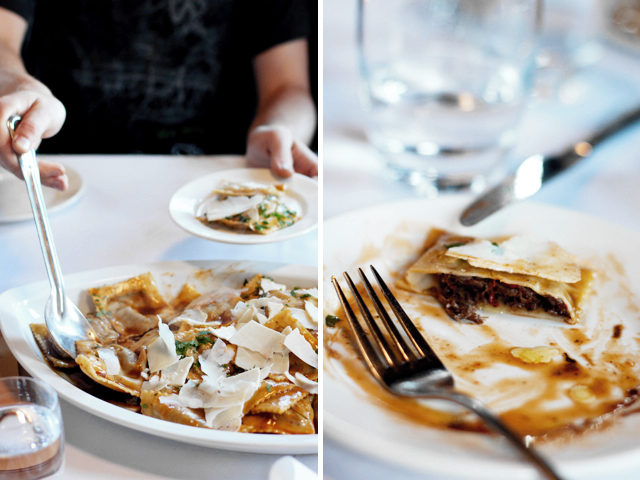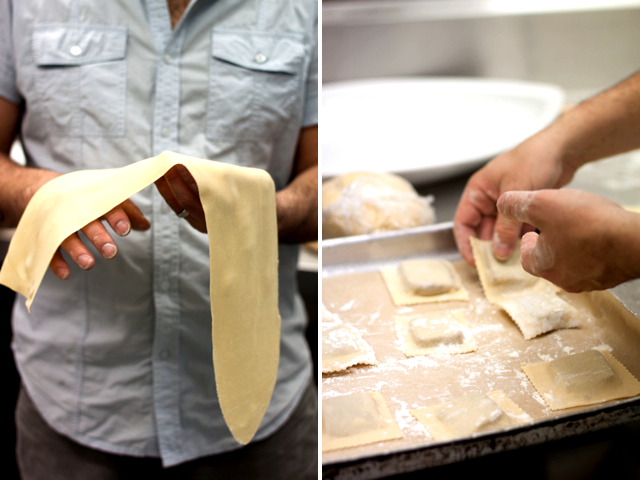I’ve been a bit obsessed with pork lately, especially since organising a dinner party for my fellow pig-loving friends using a different cut of pork in each course and writing about the results in a series of articles for Food52. My husband Marco and I created a menu featuring a fair bit of offal in hearty, traditional southern Italian and Tuscan recipes (an unusual mix, but oh do they know what to do with pork!).
One of the best things about organising this pig degustation was tracking down the ingredients and, in particular, the offal. I discovered that sharing a love of offal is the way to become friends with your butcher and that becoming friends with your butcher is a really, really good thing. Our local butchers at Brenta Meats (below) also happen to be Italian, so it didn’t take long for us to become regulars at this friendly family-run butcher shop where Marco can relish in being able to banter with butchers in his own language.

Butchers do like to chat, especially about food. I spoke with the charming Andrew Brenta (above right) about offal trends and something I am constantly curious about – why so many people (who don’t come from an Italian or other background where offal traditions are strong) don’t seem to eat it, let alone want to try it.
Everybody knows that butchers are the ones in the know about which are the best cuts of meat, the underrated cuts that people would do well to use more often. One of Andrew’s favourites is beef cheeks, which are great when slow cooked to fall-apart perfection as a tasty ragu or stew, and I would have to say the same for pork cheeks. Any cheek in my opinion the best place to start for an offal-virgin – they’re delicious but also cheap and forgivingly easy to cook.
My first taste for pork cheeks was while helping friends ‘fare il maiale’ on their farm in San Gimignano – after butchering the pig and making the prosciutto, sausages and finocchiona (my favourite Tuscan salumi, named after its distinct fennel seed flavouring), nothing was wasted and the pork cheeks were cooked into a rich stew of tegamata. It was the reward, accompanied by much wine drinking, for a hard weekend’s work involving the whole family.
I have never been able to forget the heartiness and full flavour of this dish, or the wonderful way of dishing it up out of a big terracotta pot (the same pot, or tegame, that gives the dish its name) to share around the table.



We wanted to recreate the tegamata but what also came to mind was a beautiful pork cheek-filled cannelloni dish I had seen in Ethan Stowell’s New Italian Kitchen (you know my favourites are the classics like Artusi and Ada Boni but this is one excellent recipe book by a modern chef that truly understands traditional Italian cuisine – highly recommended). Ethan braises pork cheeks then separates the meat from the braising liquid, using the meat to fill the cannelloni and the liquid as the sauce. Brilliant.
We recreated the tegamata dish from memory, braising the pork cheeks with freshly grilled red and yellow peppers (the original dish was made with home-pickled grilled peppers), to make ravioloni, large ravioli, that we could serve on a large platter for people to help themselves. The cheeks melt down into incredibly soft and tender pieces, creating a rich, silky, ever so sticky and unbelievably tasty sauce. Not a single drop of the sauce was wasted, with our friends even partaking in that favourite Italian habit, the scarpetta, to sop up the sticky sauce.

Ravioloni filled with braised pork cheeks and peppers
Serves 4
For the pasta:
- 400 grams of flour (or, even better, use a mixture of half plain flour, half fine semolina flour)
- 4 eggs
For the filling:
- 1 kg pork cheeks, roughly chopped
- 1 large red pepper (capsicum)
- 1 large yellow pepper
- Plenty of fresh sage and rosemary
- 2 fresh bay leaves
- 1 cup of white wine
- 2-3 tablespoons of tomato paste (optional)
- 40 grams of good quality butter
- Parmesan cheese, shaved
- Olive oil
- Salt and pepper
Prepare the peppers by chopping them in half, removing the seeds and then laying them on a baking sheet, cut side down, and placing under a grill until well-browned (or even blackened). Set aside, covered with some foil, until cool enough to handle and remove the skin and stems. Chop into small pieces and set aside.
Prepare a herb mixture by chopping in a food processor (or with a mezzaluna, if you’re the more romantic type) equal amounts of fresh sage and rosemary leaves. Pulse until the herbs are very finely chopped, then place in a small, clean jar and fill with olive oil to cover. This is something that I was shown by Donna, the wonderful cook who made me my first tegamata, use it in spoonfuls for stews, ragu or marinades for example. When covered with olive oil, it will keep well in the fridge for weeks.
Season the roughly chopped pork cheeks with salt and pepper.
Heat a small amount of olive oil gently in a large saucepan, add a tablespoon of the herb mixture, then the pork cheeks. Let the pork cheeks brown, cooking them for a couple of minutes on each side then deglaze the pan with the wine. Add the bay leaves, the tomato paste and water (you could also use stock if you prefer) to cover.
Cover the pan with a lid and let it slowly simmer away for a couple of hours (check on it here and there to make sure the liquid is not reducing too quickly) or until the meat falls apart easily and the liquid has reduced to a thick sauce. Before taking off from the heat, add the peppers.
Strain the stew to separate the liquid from the solid, setting aside in separate bowls or containers. If using immediately, make sure to allow the meat to cool before filling the ravioli. If you are using it the next day, be aware that refrigerating the pork cheeks will result in a solid block, like a terrine! Don’t worry about it, it will melt back down when you cook the ravioloni, but you may want to think about this and put it in an appropriately shaped container – square or rectangular makes easy cutting into the right size and shape to fill your ravioloni later.
For the pasta, take a look at the instructions (minus the squid ink, obviously) on the recipe in this post. You want pasta as thin as you can get it, so thin that you can see your fingers through it. Roll the dough into wide strips (we made ravioloni about 6-7cm wide, so you want a strip that is double that width), place a square or spoonful of pork cheek along one side of the strip lengthways with a space of about an inch between each one (do this by eye, don’t worry about measuring it out but you do want to take into consideration a border of pasta about 1cm wide for these ravioloni).
Brush the surrounding pasta dough with water. Fold over the strip lengthways to close the ravioli and – this is the slightly tricky part – working from one end to the other to avoid trapping air inside which could cause the ravioli to open during cooking, use the side of your palm to gently press down the edges of the dough to seal.
Cut the ravioloni with a sharp knife or a pastry cutter (if you have one, I prefer the crimped edge, it just helps hold a little more sauce). These are quite large and hearty, I would suggest 4 per person is a good portion – but you may want to make a few extra!
For the sauce, simply heat the braising liquid with some fresh, whole sage leaves and the butter (make sure it’s a delicious butter, this is part of your sauce!). Season to taste. When the butter has melted and has turned the sauce into a glossy, shiny thing, set the pan aside while you cook the ravioloni.
Heat a wide pot with water and bring it to a simmer. Salt your water before adding the ravioloni. They will only take about 3 minutes to cook. Remove them carefully with a slotted spoon and place into the pan of sauce. Toss over a gentle heat until the ravioloni are coated then serve with some shaved Parmesan cheese.





Comments
Fabulous ravioloni! I’ve never had pork cheeks, but I am looking forward to cooking with that cut of meat. I have read so much about it…
Cheers,
Rosa
It’s probably more suited to cold weather cooking (like anything that works well when cooked slowly for ages!) but I’d definitely recommend trying it!
I really enjoyed reading about this feast Emiko, well done!
Wonderful article. Wonderful photos. I enjoyed learning about offal. You’re right, haven’t come across it often nor heard much about it in the food world. Thank you!
Reading about your feast, I’ve been sorely tempted to hop on a plane to Tuscany, find the relatives living there I’ve never met and not come back until I’ve tried each and every thing you’ve mentioned.
Thanks for sharing, not to mention the inspiration!
Thank you Katy! You have relatives in Tuscany? What are you waiting for? 😉
This recipe looks so good, I cannot handle it! The first photo-that platter of the ravioli-I feel the overwhelming urge to stick a spoon right through the computer screen and take a bite. Love the photos, especially the end of the meal.
Wouldn’t it be nice to be able to do that?! You’d be welcome anytime! 🙂
This looks just so delicious…like always, your photos and your recipes are a great inspiration!
This sounds and looks absolutely devine!!!
BEautiful pictures, as always! x
I made this tonight and found it really bland, it needs more depth – definitely stock not water and some garlic and other classic casserole vegetables to give the meat and sauce flavour.
Hi Anna, I’m so sorry to hear that. I was really surprised actually as this happens to be one of the most flavourful recipes I can think of on my blog, so I can only think that it must come down to the quality of the ingredients used and, perhaps, to a lesser extent, seasoning. For this project and all the recipes involved, I did seek out the best quality pork I could find — As they say, a happy pig is a tasty pig, and in all the recipe testing I do, I can confidently say that I fully believe that free-range, locally raised pork has it’s merits! Stock can help but I always use homemade stock that is unsalted. I think the peppers give a wonderful sweetness and depth of flavour to the dish that renders other vegetables unnecessary. However, feel free to try those next time!
I’m going to make Ethan Stowell’s cannelloni recipe. I’d like to cook the filling one day ahead because I have a lot to do on the day of the party. I’m also not sure if I can find prosciutto rinds for the broth. Any suggestions?
You could substitute a piece of Parmesan rind too, if you have one handy (I always keep them, you can pop them into the freezer to save for moments like this or to add flavour to soups!). Otherwise you could maybe try a piece of ham hock, it will be a little smokier than prosciutto rind but will add flavour.